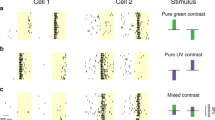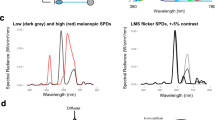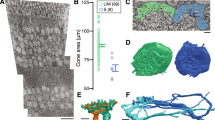Abstract
MCCOLLOUGH1 found that after alternate viewing of vertically oriented red gratings and horizontally oriented blue gratings, achromatic gratings appear tinted blue when oriented vertically and pink when oriented horizontally. This indicates the existence of colour specific edge detectors in the visual system. Further, since interocular transfer of the effect was not possible, McCollough concluded that no binocular cells are involved in this type of adaptation. This view has been supported by many investigators2–5 who used different paradigms. But their failure to illustrate orientation-contingent colour adaptation at a binocular locus may be attributable to the fact that most of their experimental situations, like McCollough's, did not provide the ideal stimulus for binocular neurones, which respond best, showing “binocular synergy”, only when the stimulus is simultaneously presented to both eyes6–9. I have attempted optimal excitation of the binocular cells by alternately presenting red vertical and blue horizontal gratings to both eyes and isolating adaptation of binocular neurones by cancelling monocular adaptation with presentation of a pair of complementary gratings (blue vertical and red horizontal) to each eye separately for an equal length of time. The results of this procedure show that adaptation does involve binocular neurones.
This is a preview of subscription content, access via your institution
Access options
Subscribe to this journal
Receive 51 print issues and online access
$199.00 per year
only $3.90 per issue
Buy this article
- Purchase on Springer Link
- Instant access to full article PDF
Prices may be subject to local taxes which are calculated during checkout
Similar content being viewed by others
References
McCollough, C., Science, 149, 1115–1116 (1965).
Murch, G. M., J. exp. Psychol., 93, 30–34 (1972).
Coltheart, M., Vision Res., 13, 2595–2598 (1973).
Over, R., Long, N., and Lovegrove, W., Percept. Psychophys., 13, 534–540 (1973).
MacKay, D. M., and MacKay, V., Nature, 242, 477–479 (1973).
Hubel, D. H., and Wiesel, T. N., J. Physiol., Lond., 160, 106–154 (1962).
Hubel, D. H., and Wiesel, T. N., J. Neurophysiol., 28, 229–289 (1965).
Barlow, H. B., Blakemore, C., and Pettigrew, J. D., J. Physiol., Lond., 193, 327–342 (1967).
Pettigrew, J. D., Nikara, T., and Bishop, P. O., Expl Brain Res., 6, 391–410 (1968).
MacKay, D. M., and MacKay, V., J. Physiol, Lond., 237, 38P–39P (1974).
Hubel, D. H., and Wiesel, T. N., J. Physiol., Lond., 195, 215–243 (1968).
Henry, G. H., Bishop, P. O., and Coombs, J. S., Vision Res., 9, 1289–1296 (1969).
Hubel, D. H., and Wiesel, T. N., J. Physiol., Lond., 155, 385–398 (1961).
Lennox-Buchthal, M. A., Vision Res., 2, 1–15 (1962).
Gouras, P., Science, 168, 489–492 (1970).
Dow, B. M., and Gouras, P., J. Neurophysiol., 36, 79–100 (1973).
Michael, C. R., Physiologist., 15, 216 (1972).
Zeki, S. M., Brain Res., 53, 422–427 (1973).
Gouras, P., J. Physiol., Lond., 238, 583–602 (1974).
Leppmann, P. K., Nature, 242, 411–412 (1973).
Mayhew, J. E. W., and Anstis, S. M., Percept. Pschophys., 12, 77–85 (1972).
Author information
Authors and Affiliations
Rights and permissions
About this article
Cite this article
VIDYASAGAR, T. Orientation specific colour adaptation at a binocular site. Nature 261, 39–40 (1976). https://doi.org/10.1038/261039a0
Received:
Accepted:
Issue Date:
DOI: https://doi.org/10.1038/261039a0
This article is cited by
Comments
By submitting a comment you agree to abide by our Terms and Community Guidelines. If you find something abusive or that does not comply with our terms or guidelines please flag it as inappropriate.



